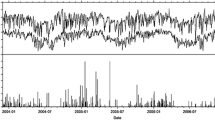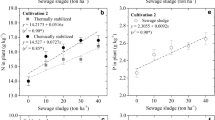Abstract
Purpose
Degraded soils, such as those encountered in areas of mine activities, need to be ameliorated by liming to correct soil acidity and by addition of organic inputs to improve soil properties and fertility.
Materials and methods
Non-amended mine soil and soil amended with stabilized sewage sludge were incubated for 45 days. Soil physicochemical and biological indicators were periodically measured along incubation and other enzyme activities at the end of incubation. In improved soils, a study of plant development in 250-g pots was carried out with three vegetal species: tomato, rye grass and ahipa. Germination and mortality rates, biomass production and photosynthetic pigments were measured.
Results and discussion
Soil incubation with sewage sludge slightly increased soil pH and led to an enhancement of soil electrical conductivity, organic carbon and dehydrogenase activity, especially for the higher doses (5 and 10%). However soil respiration was more promoted with the 2% dose, pointing to a possible toxic effect of the sludge. At the end of incubation, physicochemical and biological properties were in general enhanced. Biomass production was improved in tomato and rye grass by sewage sludge addition (more at the 2% dose), whilst ahipa growth was not affected by sewage sludge treatments. Tomato mortality reached 73% with high sludge doses (10%).
Conclusions
According to this set of parameters, amendment with sewage sludge of a limed acid mine soil would be considered as a good strategy for soil amelioration in view of plant establishment and development.



Similar content being viewed by others
References
Alvarenga P, Palma P, Gonçalves AP, Baião N, Fernandes RM, de Varennes A, Vallini G, Duarte E, Cunha-Queda AC (2008) Assessment of chemical, biochemical and ecotoxicological aspects in a mine soil amended with sludge of either urban or industrial origin. Chemosphere 72:1774–1781
Alvarenga P, Palma P, Gonçalves AP, Baião N, Fernandes RM, de Varennes A, Vallini G, Duarte E, Cunha-Queda AC (2009) Organic residues as immobilizing agents in aided phytostabilization: (II) Effects on soil biochemical and ecotoxicological characteristics. Chemosphere 74:1301–1308
Anderson JPE, Domsch KH (1978) Physiological method for quantitative measurement of microbial biomass in soils. Soil Biol Biochem 10:215–221
Arocena JM, van Mourik JM, Faz Cano A (2012) Granular soil structure indicates reclamation of degraded to productive soils: a case study in southeast Spain. Can J Soil Sci 92:243–251
Badalucco L, Grego S, Dell’Orco S, Nannipieri P (1992) Effect of liming on some chemical, biochemical, and microbiological properties of acid soils under spruce (Picea abies L.). Biol Fertil Soils 14:76–83
Chan KY, Heenan DP (1999) Lime-induced loss of soil organic carbon and effect on aggregate stability. Soil Sci Soc Am J 63:1841–1844
Chopin EIB, Alloway BJ (2007) Trace element partitioning and soil particle characterisation around mining and smelting areas at Tharsis, Ríotinto and Huelva, SW Spain. Sci Total Environ 373:488–500
Council Directive 86/278/EEC Directive on the protection of the environment, and in particular of the soil, when sewage sludge is used in agriculture. 12 June 1986
Council Directive 91/2717EEC. Directive concerning urban waste-water treatment. 21 May 1991
Curtin D, Smillie GW (1983) Soil solution composition as affected by liming and incubation. Soil Sci Soc Am J 47:701–707
de Andrés EF, Tenorio JL, Albarran MD, Walter I (2012) Carbon dioxide flux in a soil treated with biosolids under semiarid conditions. Compos Sci Util 20:43–48
de Varennes A, Abreu MM, Qu G, Cunha-Queda C (2010) Enzymatic activity of a mine soil varies according to vegetation cover and level of compost applied. Int J Phytoremediat 12:371–383
de Varennes A, Qu G, Cordovil C, Gonçalves P (2011) Soil quality indicators response to application of hydrophilic polymers to a soil from a sulfide mine. J Hazard Mater 192:1836–1841
Fernández-Caliani JC, Barba-Brioso C, González I, Galán E (2009) Heavy metal pollution in soils around the abandoned mine sites of the Iberian Pyrite Belt (Southwest Spain). Water Air Soil Pollut 200:211–226
Foolad MR (1996) Response to selection for salt tolerance during germination in tomato seed derived from P.I. 174263. J Am Soc Hortic Sci 121:1006–1011
Gascó G, Lobo MC (2007) Composition of a Spanish sewage sludge and effects on treated soil and olive trees. Waste Manag 27:1494–1500
García C, Hernández T, Costa F, Ceccanti B (1994) Biochemical parameters in soils regenerated by the addition of organic wastes. Waste Manag Res 12:457–466
García C, Hernández T, Costa F (1997) Potential use of dehydrogenase activity as an index of microbial activity in degraded soils. Commun Soil Sci Plant 28:123–134
García-Ruiz R, Ochoa V, Hinojosa MB, Carreira JA (2008) Suitability of enzyme activities for the monitoring of soil quality improvement in organic agricultural systems. Soil Biol Biochem 40:2137–2145
González-Ubierna S, Jorge-Mardomingo I, Carrero-González B, de la Cruz MT, Casermeiro MA (2012) Soil organic matter evolution after the application of high doses of organic amendments in a Mediterranean calcareous soil. J Soils Sediments 12:1257–1268
Gupta AK, Sinha S (2007) Phytoextraction capacity of the Chenopodium album L. grown on soil amended with tannery sludge. Bioresour Technol 98:442–446
Haynes RJ, Naidu R (1998) Influence of lime, fertilizer and manure applications on soil organic matter content and soil physical conditions: a review. Nutr Cycl Agroecosyst 51:123–137
Haynes RJ, Swift RS (1988) Effects of lime and phosphate additions on changes in enzyme activities, microbial biomass and levels of extractable nitrogen, sulphur and phosphorus in an acid soil. Biol Fertil Soils 6:153–158
Hernández-Soriano MC, Degryse F, Smolders E (2011) Mechanisms of enhanced mobilisation of trace metals by anionic surfactants in soil. Environ Pollut 159:809–815
Hueso S, Brunetti G, Senesi N, Farrag K, Hernández T, García C (2012) Semiarid soils submitted to severe drought stress: influence on humic acid characteristics in organic-amended soils. J Soils Sediments 12:503–512
Jones BEH, Haynes RJ, Phillips IR (2012) Addition of an organic amendment and/or residue mud to bauxite residue sand in order to improve its properties as a growth medium. J Environ Manage 95:29–38
Kandeler E, Luxhoi J, Tscherko D, Magid J (1996) Influence of heavy metals on the functional diversity of soil microbial communities. Biol Fertil Soils 23:299–306
Kenneth E, Pallet KE, Young J (2000) Carotenoids. In: Ruth GA, Hess JL (eds) Antioxidants in higher plants. CRC Press, Boca Raton, pp 60–81
Khan S, Hesham AEL, Qiao M, Rehman S, He JZ (2010) Effects of Cd and Pb on soil microbial community structure and activities. Environ Sci Pollut Res 17:288–296
Ladd JN, Butler JHA (1972) Short-term assays of soil proteolytic enzyme activities using proteins and dipeptide derivatives as substrates. Soil Biol Biochem 4:19–30
Lichtenthaler HK, Buschmann C (2001) Chlorophylls and carotenoids: measurement and characterization by UV–VIS spectroscopy. Curr Protoc Food Analyt Chem F4.3.1-F4.3.8
Mingorance MD, Barahona E, Fernández-Gálvez J (2007) Guidelines for improving organic carbon recovery by the wet oxidation method. Chemosphere 68:409–413
Nannipieri P, Kandeler E, Ruggiero P (2002) Enzyme activities and microbiological and biochemical processes in soil. In: Burns RG, Dick RP (eds) Enzymes in the environment. Activity, ecology and applications. Marcel Dekker, N.Y, pp 1–33, Chapter 1
Pardo T, Clemente R, Bernal MP (2011) Effects of compost, pig slurry and lime on trace element solubility and toxicity in two soils differently affected by mining activities. Chemosphere 84:642–650
Passuello A, Mari M, Nadal M, Schuhmacher M, Domingo JL (2010) POP accumulation in the food chain: integrated risk model for sewage sludge application in agricultural soils. Environ Int 36:577–583
Paz-Ferreiro J, Gascó G, Gutiérrez B, Méndez A (2012) Soil biochemical activities and the geometric mean of enzyme activities after application of sewage sludge and sewage sludge biochar to soil. Biol Fertil Soils 48:511–517
Rossini Oliva S, Mingorance MD, Valdés B, Leidi EO (2010) Uptake, localisation and physiological changes in response to copper excess in Erica andevalensis. Plant and Soil 328:411–420
Sáez R, Almodóvar GR, Pascual E (1996) Geological constraints on massive sulphide genesis in the Iberian Pyrite Belt. Ore Geol Rev 11:429–451
Salkield LU (1987) A technical history of the Rio Tinto mines. Some notes on exploitation from pre-phoenician times to 1950s. The Institution of Mining and Metallurgy, 114 pp
Saviozzi A, Bufalino P, Levi-Minzi R, Riffaldi R (2002) Biochemical activities in a degraded soil restored by two amendments: a laboratory study. Biol Fertil Soils 35:96–101
Serra-Wittling C, Houot S, Barriuso E (1996) Modification of soil water retention and biological properties by municipal solid waste compost. Compos Sci Util 4:44–52
Singh S, Sinha S (2005) Accumulation of metals and its effects in Brassica juncea L. Czern. (var. rohini) grown on various amendments of tannery waste. Ecotoxicol Environ Saf 62:118–127
Smith SR (2009) A critical review of the bioavailability and impacts of heavy metals in municipal solid waste composts compared to sewage sludge. Environ Int 35:142–156
Tabatabai MA, Bremner JM (1970) Arylsulfatase activity of soils. Soil Sci Soc Am Proc 34:225–229
Tabatabai MA (1994) Soil enzymes. In: Mickelson SH, Bigham, JM (eds) Methods of soil analysis. Part 2. Soil Science Society of America, Madison, WIS. pp. 775–833
Tamir G, Shenker M, Heller H, Bloom PR, Fine P, Bar-Tal A (2011) Can soil carbonate dissolution lead to overestimation of soil respiration? Soil Sci Soc Am J 75:1414–1422
Tejada M, Moreno JL, Hernandez MT, García C (2008) Soil amendments with organic wastes reduce the toxicity of nickel to soil enzyme activities. Eur J Soil Biol 44:129–140
Trasar-Cepeda C, Leirós MC, Seoane S, Gil-Sotres F (2000) Limitations of soil enzymes as indicators of soil pollution. Soil Biol Biochem 32:1867–1875
Tyler G (1974) Heavy metal pollution and soil enzymatic activity. Plant and Soil 41:303–311
Weishaar JL, Aiken GR, Bergamaschi BA, Fram MS, Fujii R, Mopper K (2003) Evaluation of specific ultraviolet absorbance as an indicator of the chemical composition and reactivity of dissolved organic carbon. Environ Sci Technol 37:4702–4708
Ye ZH, Shu WS, Zhang ZQ, Lan CY, Wong MH (2002) Evaluation of major constraints to revegetation of lead/zinc mine tailings using bioassay techniques. Chemosphere 47:1103–1111
Zsolnay A (2003) Dissolved organic matter: artefacts, definitions and functions. Geoderma 113:187–209
Acknowledgments
Thanks to Proyecto de Excelencia, Junta de Andalucía (P10-RNM5814), cofinanced with European FEDER-FSE funds. The technical assistance of Isabel Cañadas is gratefully acknowledged. EMASAGRA is thanked for the kind supply of stabilized sewage sludges. Carbocal was kindly provided by Juan Castellano Márquez.
Author information
Authors and Affiliations
Corresponding author
Additional information
Responsible editor: Hailong Wang
Rights and permissions
About this article
Cite this article
Mingorance, M.D., Rossini Oliva, S., Valdés, B. et al. Stabilized municipal sewage sludge addition to improve properties of an acid mine soil for plant growth. J Soils Sediments 14, 703–712 (2014). https://doi.org/10.1007/s11368-013-0743-x
Received:
Accepted:
Published:
Issue Date:
DOI: https://doi.org/10.1007/s11368-013-0743-x




